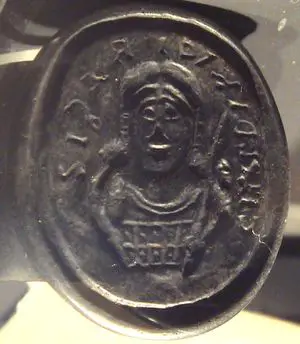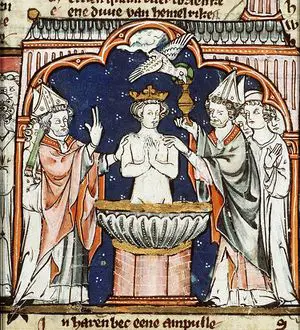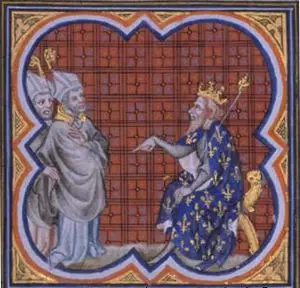How Did the Merovingian Dynasty Impact European History
When the authority of Rome was collapsing in western Europe in the fourth and fifth centuries BC, wave after wave of Germanic tribes – and some non-Germanic tribes – attempted to fill the void. Vandals, Visigoths, Ostrogoths, and Burgundians were just some of the better known warbands that attempted to carve out kingdoms for themselves from the corpse of the decaying Roman Empire. Most of these Germanic kingdoms were ephemeral, often collapsing just as quickly as they rose, but one people impacted Western Europe more profoundly and over a much longer time period – the Franks.
The Franks, more specifically the Frankish Merovingian Dynasty (c. AD 440s – 751), brought stability and order to Gaul in the wake of the Roman collapse, eventually giving the land its modern name. But the kings of the Merovingian Dynasty did more than rename Gaul; they gave it its cultural identity that persisted through the medieval period into modern times. The Merovingians established the borders of Gaul/France, ensured that France would be a Catholic nation, and paved the way for the later, more powerful Carolingian Dynasty.
Early Frankish History
The precise origins of the Franks are somewhat shrouded in mystery as they were just one of many Germanic tribes that lived east of the Rhine River on the limes of the Roman Empire. The reconstruction of early Frankish history is based on a combination of archaeology, late Roman sources, and the writings of Gregory the Bishop of Tours (538-594), who besides basing his work on contemporary observations referred to the works of the now lost late fourth century writer Sulpicius Alexander and the fifth century historian Profuturus Frigeridus. Early Frankish cultural identity was in large part formed around conflict with the Romans, with there being two notable sub-tribes of the Franks – the Ripurarians and the Salians. [1] The Salians were the more dominant of the two tribes and are believed to have comprised the Frankish warrior elite class. The term “Frank” is often translated as “ferocious” or “bold,” but it was the Salians who were the boldest, pushing their way into Gaul in the fourth century. [2]
The Franks crossed the Rhine and began inhabiting the region now known as Flanders by 358. [3] The Franks took advantage of the weakening Roman establishment, essentially filling the power vacuum as the Romans slowly retreated. Gregory of Tours described the slow and steady process in his history of the Franks.
“It is commonly said that the Franks came originally from Pannonia and first colonized the banks of the Rhine. Then they crossed the river, marched through Thuringia, and set up in each country district and each city long-haired kings chosen from the foremost and most noble of their race.” [4]
Once in Gaul, the Franks established a complex relationship with the Romans that was dependent on the needs of each group. The Rhine River at the time represented a political but not a cultural boundary: Franks on both sides had contact with each other, even as those in Gaul were more Romanized. The Franks in northern Gaul were the most Romanized and willing to work with the Romans. By the fourth century, northern Gaul acted as the new buffer between what was left of the Roman Empire and the ever encroaching limes to the north and west. [5] For their part, the Franks proved to be beneficial to the Romans as they manned their ever diminishing army and protected the borders. The Romans settled Franks captured in battle in northern Gaul to populate the buffer zone and to provide a steady source of recruits for the army to be used elsewhere. [6] The Franks of northern Gaul were given a fair amount of autonomy, which allowed them to create a stable dynasty by the middle of the fifth century, just before the collapse of the western Roman Empire.
The Establishment of the Merovingian Dynasty
The identity of the first king of the Merovingian Dynasty is still debated by some scholars. Most believe that the first Merovingian king was a Salian Frank named Clodio, who came to power in AD 431. Clodio was than succeeded by Merovech, from whom the dynasty was named. [7] Little is known about Merovech’s rule, although it is known that he was followed by Childeric.
Childeric is considered by some to be the true father of the Merovingian Dynasty, as it was under his rule that the Franks began to play a much more important role in European affairs. Under Childeric, the Franks became federates of the Roman Empire and fought on the side of the Romans at the Battle of Orleans against the Visigoths in 463 or 464. Childeric also led his people against the Saxons that were in Gaul. [8] All of these battles and movements of peoples took place as the western Roman Empire was about to collapse. Finally, in 476 the last emperor in the west was deposed, leaving remnants of the Roman army to fight it out with the Franks, Visigoths, and other Germanic tribes. A Roman general name Syagrius claimed hegemony over Gaul, which was not effectively challenged for some time after Childeric died in 481.
Clovis the Conqueror
After Childeric died, the Merovingian Dynasty continued but it was relegated to being a local power. Childeric’s wife Basina gave birth to a son named Clovis, who through a combination of diplomacy and brutality would become the greatest of all Merovingian kings. Clovis assumed the Merovingian throne and by 486 he challenged Syagrius’ right to rule over Gaul. Although Rome no longer had true control over Gaul, remnants of Roman authority remained and the Eastern Roman/Byzantine Emperor Zeno (ruled 476-491) recognized Syagrius as Rome’s representative. But Clovis believed that the Franks should rule Gaul and that he would better represent Zeno’s interests, so he went to war against Syagrius in 486. After losing the initial battle to the Franks near Soissons, Syagrius fled south to Alaric II and the Visigoths, who not wanting war with Clovis promptly turned over the Roman general. Clovis executed Syagrius and then claimed his lands, which stretched from the Rhine to the Seine River. [9] The bellicose Merovingian king then consolidated his gains, paid his loyal warriors, and waited for the next opportunity.
Clovis’ next opportunity to expand the Merovingian kingdom came when the neighboring Germanic tribe, the Alamanni, crossed the Rhine River into Ripuarian Frank territory. Although the movement was not a direct threat to Clovis, it gave the ambitious king a casus belli to attack the Alamanni. According to Gregory, the Bishop of Tours, Clovis had a religious epiphany during the battle that was similar to the one experienced by Constantine the Great nearly 200 years prior.
“Finally war broke out against the Alamanni and in this conflict he was forced by necessity to accept what he had refused of his own free will. It so turned out that when the two armies me ton the battlefield there was a great slaughter and the troops of Clovis were rapidly being annihilated. He raised his eyes to heaven when he saw this, felt compunction in his heart and was moved to tears. ‘Jesus Christ,’ he said, ‘you who Clotild maintains to be the Son of the living God, you who deign to give help to those in travail . . . If you will give me victory over my enemies . . . I will be baptized in your name. I have called upon my own gods, but, as I see only too clearly, they have no intention of helping me.’ . . Even as he said this the Alamanni turned their backs and began to run away. As soon as they saw their King was killed, they submitted to Clovis.” [10]
Clovis the Christian
The reality is that Clovis’ conversion to Christianity was much more cynical than Gregory’s already somewhat cynical account indicates. By the time Clovis became king, the old warrior religion that the early Franks practiced was quickly being replaced by Christianity – it was only a matter of which version would win. The Arian form was favored by the Goths, but bolstered by its organization, the Roman Church was quickly gaining ground by the late fifth century. Two of Clovis’ sisters were Arian Christians, while his wife Coltilda was a Roman Catholic. Perhaps partly due to his wife’s influence, but also to appease the Romanized people of Gaul, Clovis chose to be baptized as a Roman Catholic. [11]
Clovis was probably baptized in the cathedral of St. Martin in Tours in 496 in front of a large crowd. [12] The baptism marked a true turning point in European history: Gaul was no longer pagan and the Merovingians would from that point on be militant defenders of the Roman Catholic Church. Gregory wrote that more than 3,000 of Clovis’ men were baptized right after him, [13] which even if done in name only represents a significant number. But Clovis was not willing to be a Catholic in name only, he was willing to do the Lord’s and the Pope’s work through his sword.
In 507, Clovis declared war on the Visigoths, who were still occupying southern Gaul at the time. The final battle between Alaric II and the Visigoths and Clovis and the Franks took place near Campus Volgaldensis (modern Vouillé). Gregory recorded that Alaric was killed and Clovis nearly so during the battle.
“Clovis killed Alaric, but, as the Goths fled, two of them suddenly rushed up in the scrum, one on this side and one on that, and struck at the Frankish King with their spears. It was his leather corselet which saved him and the sheer speed of his horse, but he was very near to death.” [14]
The victory unified almost all of Gaul under Clovis’ rule, with the exception of the outlying regions of Septimania, Burgundy, Provence, Breton, and Armorica. [15] Most importantly, though, was Clovis’ acceptance by three very important constituencies.
The Church accepted Clovis and the Merovingian Dynasty completely after the victory at Campus Vogaldensis because the Visigoths were Arian Christians. Although Clovis may have viewed the war and victory from the practical perspective of increasing his lands and wealth, the Church leaders saw it as a spiritual victory. [16]
The victory also legitimized Clovis and the Merovingian Dynasty in the eyes of the Ripurian Franks, who elected him as their king, giving the Merovingians control of the Rhineland around Koln. [17] Clovis then had to further solidify his position by eliminating all threats from within the dynasty.
“The two Kings of whom I have told you, Ragnachar and Ricchar, were relatives of Clovis. At his command their brother Rignomer was also put to death in Le Mans. As soon as all three were slain, Clovis took over their kingdom and their treasure.” [18]
For all his efforts in Gaul and on behalf of the Roman Catholic Church, the Byzantine Emperor Anastasius I Dicorus (ruled 491-518) bestowed on Clovis the title of “Consul of Rome.” [19] Although the title was purely ceremonial as Rome has effectively ceased to function, it still carried with it a certain amount of gravitas. The use of Roman styles and titles was also later duplicated by the Carolingian Frankish king, Charlemagne. When Clovis finally died in 511, he left the later Merovingian kings with a strong and wealthy dynasty that ruled over most of what is today France.
Conclusion
The Merovingian Dynasty is often overshadowed by the later, better know Carolingian Dynasty, but the Merovingians were just as important in European history. The Merovingian kings helped Gaul transition somewhat seamlessly from Roman to Frankish rule and in doing so would establish many of the political borders of Europe that still exist. The greatest of all Merovingian kings, Clovis, also ensured that France would become a Roman Catholic country and helped to establish many of France’s cultural traits in the process, clearing the way for the later Carolingian Dynasty to expand beyond Gaul’s/France’s borders.
References
- Jump up ↑ Miller, David Harry. “Ethnogenesis and Religious Revitalization beyond the Roman Frontier: The Case of Frankish Origins.” Journal of World History. 4 (1993) p. 277
- Jump up ↑ Miller, pgs. 283-5
- Jump up ↑ Bury, J. B. The Invasion of Europe by the Barbarians. (New York: W. W. Norton and Company, 1967), p. 220
- Jump up ↑ Gregory of Tours. The History of the Franks. Translated by Lewis Thorpe. (London: Penguin, 1974), Book II, 9
- Jump up ↑ Barlow, Jonathan. “Kinship, Identity and Fourth-Century Franks.” Historia: Zeitschrift für Alte Geschichte. 45 (1996) pgs. 228-9
- Jump up ↑ James, Edward. “The Northern World in the Dark Ages, 400-900.” In The Oxford History of Medieval Europe. Edited by George Holmes. (Oxford: Oxford University Press, 2001), pgs. 61-62
- Jump up ↑ Bury, pgs. 219-20
- Jump up ↑ Bury, p. 225
- Jump up ↑ Bury p. 232
- Jump up ↑ Gregory of Tours, Book II, 30
- Jump up ↑ James, p. 68
- Jump up ↑ Bury, p. 242
- Jump up ↑ Gregory of Tours, Book II, 31
- Jump up ↑ Gregory of Tours, Book II, 37
- Jump up ↑ Bury, p. 249
- Jump up ↑ Bury, p, 250
- Jump up ↑ Bury, p. 250
- Jump up ↑ Gregory of Tours, Book II, 42
- Jump up ↑ Bury, p. 252



